Even if you’ve never made homemade bread or worked with yeast before, this homemade crusty artisan bread is for you. It’s the perfect beginner recipe because it only requires 4 ingredients without any special pans or mixer, there’s no kneading or complicated shaping involved, and 95% of the work is hands-off. Bread masters will appreciate this recipe too because it delivers with delicious flavor, a slightly crisp and mega chewy crust, and those signature soft holes inside like ciabatta or French bread.

Bread Beginners—Start Here
Have you ever wanted to master homemade bread? Real, crusty, chewy, delicious bakery-style loaves that taste incredible with dips, soups, sauces, and comforting dinners? This recipe is where you start. This artisan bread is for beginners, but even bread masters will appreciate its flavor and ease. It’s so fresh, so flavorful, and so surprisingly easy because it basically makes itself.
You only need 4 ingredients without any special pans or mixer, there’s no kneading, no poolish or dough starter required, and you can add herbs, cheeses, and spices to make a variety of bread flavors.
This base recipe will soon be on repeat in your kitchen. After you realize how easy it is to make real homemade bread, you’ll find any excuse to bake a loaf.

What is Homemade Artisan Bread?
When it comes to bread, the term “artisan” doesn’t mean 1 particular thing. But generally, artisan bread is homemade, fresh, crusty, and deliciously rustic looking. An artisan is a skilled worker, one who works with their hands. But ironically, there isn’t much “work” involved with this recipe.
Why You’ll Love This Bread
- Easier than you ever imagined
- Soft + flavorful
- Chewy, slightly crisp crust
- Shape however you want
- No special pans, poolish, or dough starter required
- Only 4 ingredients
- You decide the length of time it rests
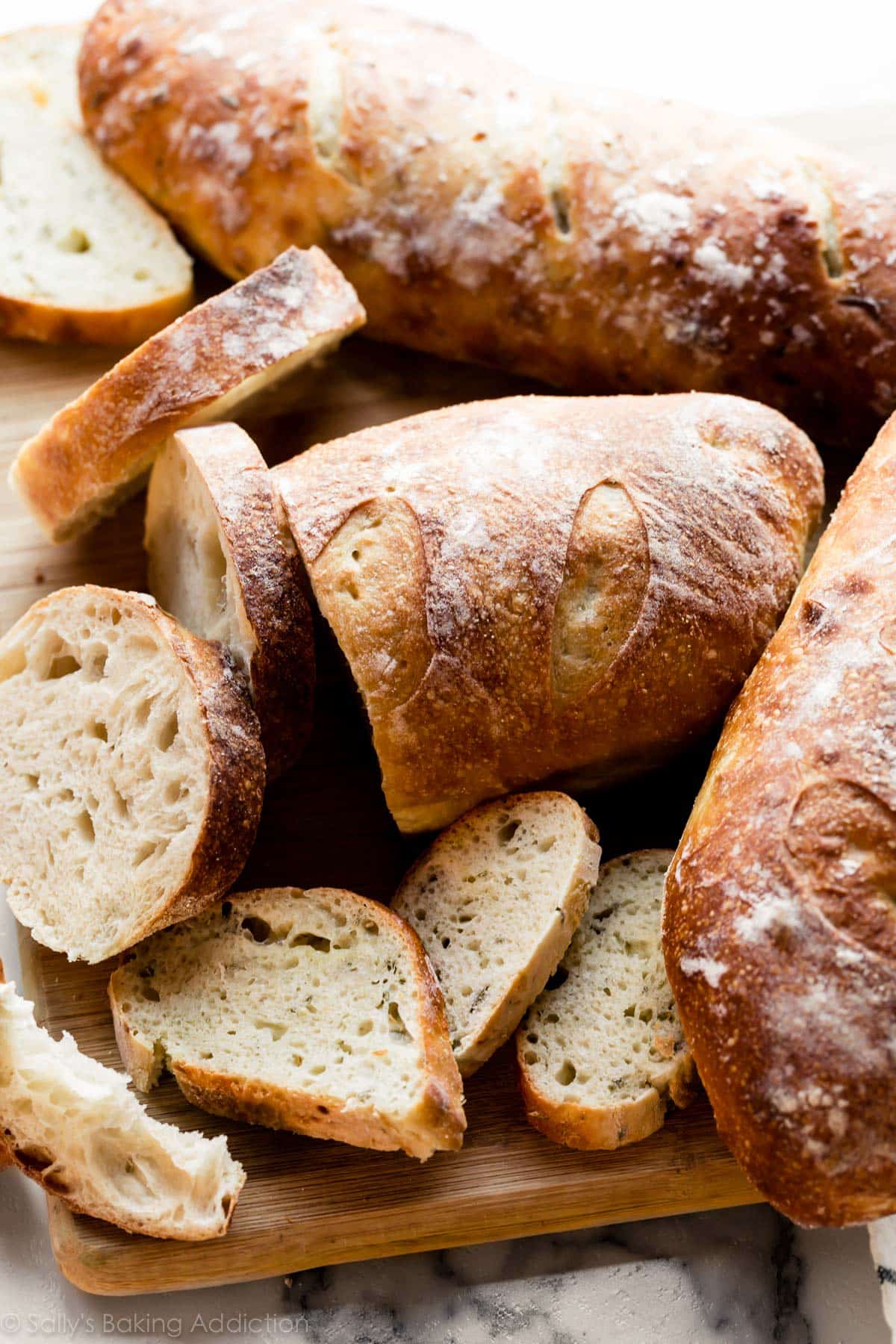
Homemade Artisan Bread Video Tutorial
Like sandwich bread, whole wheat bread, focaccia, homemade English muffins, seeded oat bread, and homemade bagels—the process is surprisingly easy. If you’re new to yeast, reference my Baking with Yeast Guide for answers to common yeast FAQs.
Only 4 Ingredients
The crustier and chewier the bread, the less fat in the dough—also known as a “lean dough.” We’re using a lean dough for our artisan loaf today. (If you’re curious, a “rich dough” is a soft bread dough with the presence of fat, such as butter and eggs—the kind we need for overnight cinnamon rolls and honey butter rolls.) Without fat, we’re left with the basics.
- Bread Flour: While you can use all-purpose flour in this recipe, I strongly recommend using bread flour. Just like when we make olive bread, bread flour produces a stronger, chewier bread and that makes a big difference in recipe with only 3 other ingredients.
- Instant Yeast: Instant yeast is key in this recipe. While you can use active dry if that’s all you have, any quick rise or instant yeast will produce flavorful results in less time. I use more yeast in this recipe compared to my cranberry nut no-knead bread and no-knead jalapeño cheddar bread. Why? Those doughs rest and rise at room temperature. However, for more flavor and just as much rise, I use more yeast and let the this dough rest in the refrigerator. (Cool air slows the fermentation process.)
- Salt: You can’t make good bread without salt and for best flavor, I recommend a coarse salt, such as coarse sea salt. I find the bread’s flavor lacking with regular table salt.
- Water: I normally encourage you to use warm liquid with yeast because warm liquid helps the yeast work faster. However, use cool or room temperature water here. Not freezing cold, not super warm—cool to touch. 70°F (21°C) is great, but the exact temperature doesn’t matter as long as it’s not hot or warm. The cooler the water, the longer the dough takes to rise and, usually, the better the bread’s flavor. (This is important since there are so little ingredients to add substantial flavor!) We use the same cool water method for no knead honey oat bread.
- Optional Cornmeal: Dusting the pan with cornmeal adds a pop of flavor and a little crunch to the bottom crust. This is completely optional. If you have it, use it. If you don’t have it, don’t worry about it.
You can also add herbs and seasonings such as garlic, rosemary, dill, chopped onion, jalapeño, shredded cheese, chopped nuts, dried cranberries, etc. My no yeast bread is the quick bread alternative here—you can add flavors to that loaf, too!

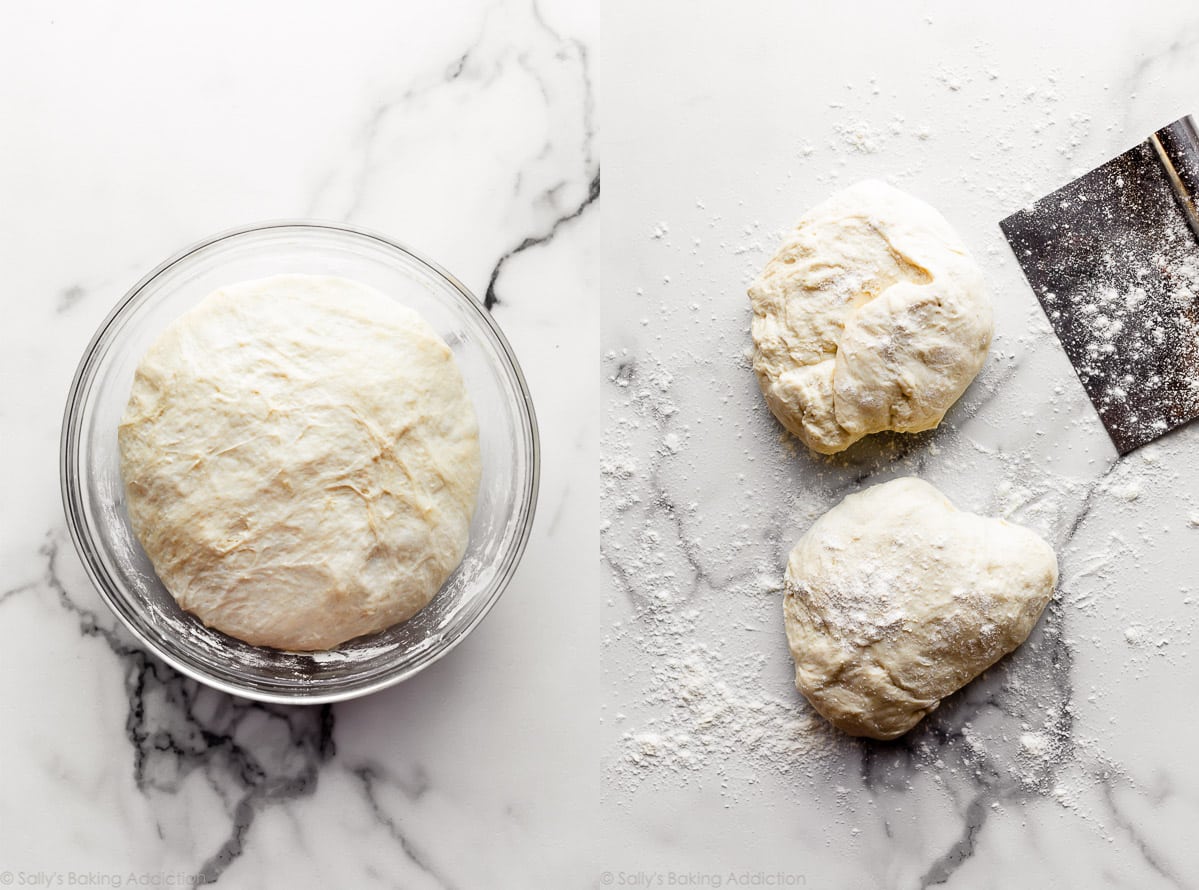
Baker’s Tip: Avoid adding too much flour to the dough as you work with it. The stickier it is—and the longer it sits in the refrigerator—the more likely you’ll have those big airy pockets of air in the crumb.

How to Make Homemade Artisan Bread in 5 Steps
- Mix the dough ingredients together. At first the dough will seem very dry and shaggy and you’ll question if it will even come together. But it will. Use a spatula at first, then switch to your hands to ensure all of the flour is moistened. The dough is actually a little sticky after it’s thoroughly mixed.
- Let it rise at room temperature for 2-3 hours. Cover the dough and let it rise at room temperature for about 2-3 hours until doubled in size.
- Use right away or refrigerate. After 2-3 hours, you can immediately continue with the next step. However, for ideal flavor and texture, I strongly recommend letting the dough sit in the refrigerator for at least 12 hours and up to 3 days. Yes, 3 full days! I usually only let it rest for about 18 hours. During this crucial step, the cold air slows the fermentation process and adds so much flavor and texture. So, you can bake bread in 2-3 hours or in 3 days. The longer it sits, the better it tastes. 🙂
- Shape into 2 loaves or 1 boule. Rest as oven preheats. You can shape the bread into a round loaf (boule) or two longer loaves. I usually make 2 longer loaves side-by-side on a flat baking sheet, about 9×3 inches each. Score with a sharp knife or bread lame. Preheat the oven to a very hot 475°F (246°C). The extremely hot air will immediately set the crust so the bread rises up instead of spreading all over. To help ensure a crispier crust, after the oven pre-heats—pour boiling water into a metal or cast iron baking pan/dish on the bottom oven rack. Immediately place the dough inside and shut the oven door to trap the steam. The steam will help create that coveted crisp crust. If you have a dutch oven, shape the dough into 1 round loaf, and bake it inside the dutch oven with the lid on.
- Bake until golden brown, about 20-25 minutes. Gently tap the loaves because if they sound hollow, they’re done.
Look at those deliciously soft holes inside! Reminds me of ciabatta or a French baguette, both of which can be a little more complicated to make.


Serve Artisan Bread With
- Slather with homemade honey butter
- Slice and dunk in crab dip, beer cheese dip, or roasted garlic bacon spinach dip
- Serve alongside slow cooker chicken chili or pumpkin chili
- As a dunker for minestrone soup or creamy chicken noodle soup
- With a big bowl of mac & cheese
- Use for my goat cheese & honey crostini
- It’s the perfect starch in breakfast casserole
- With anything because homemade bread is everything’s best friend
See Your Homemade Artisan Bread!
Many readers tried this recipe as part of a baking challenge! Feel free to email or share your recipe photos with us on social media. 🙂
Print
Homemade Artisan Bread Recipe
- Prep Time: 4 hours
- Cook Time: 25 minutes
- Total Time: 4 hours, 25 minutes
- Yield: 2 8-inch loaves
- Category: Bread
- Method: Baking
- Cuisine: American
Description
Even if you’ve never made homemade bread or worked with yeast before, this homemade artisan bread is for you. Watch the video tutorial below and review the recipe instructions and recipe notes prior to beginning. If you’re new to working with yeast, reference my Baking with Yeast Guide for answers to common yeast FAQs.
Ingredients
- 3 and 1/4 cups (about 430g) bread flour (spooned & leveled), plus more for hands and pan
- 2 teaspoons (about 6g) instant yeast
- 2 teaspoons (about 9g) coarse salt (see note)
- 1 and 1/2 cups (360ml) water, close to room temperature at about 70°F (21°C)
- optional: cornmeal for dusting pan
Instructions
- In a large un-greased mixing bowl, whisk the flour, yeast, and salt together. Pour in the water and gently mix together with a silicone spatula or wooden spoon. The dough will seem dry and shaggy, but keep working it until all the flour is moistened. If needed, use your hands (as I do in the video tutorial below) to work the dough ingredients together. The dough will be sticky. Shape into a ball in the bowl as best you can.
- Keeping the dough in the bowl, cover the dough tightly with plastic wrap or aluminum foil and set on the counter at room temperature (honestly any normal room temperature is fine!). Allow to rise for 2-3 hours. The dough will just about double in size, stick to the sides of the bowl, and have a lot of air bubbles.
- You can continue with step 4 immediately, but for absolute best flavor and texture, I strongly recommend letting this risen dough rest in the refrigerator for at least 12 hours and up to 3 days. Place covered dough in the refrigerator for 12 hours – 3 days. I usually let it rest in the refrigerator for about 18 hours. The dough will puff up during this time, but may begin to deflate after 2 days. That’s fine and normal—nothing to worry about.
- Lightly dust a large nonstick baking sheet (with or without rims and make sure it’s nonstick) with flour and/or cornmeal. Turn the cold dough out onto a floured work surface. Using a sharp knife or bench scraper, cut dough in half. Some air bubbles will deflate as you work with it. Place dough halves on prepared baking sheet. Using floured hands, shape into 2 long loaves about 9×3 inches each (doesn’t have to be exact) about 3 inches apart. Loosely cover and allow to rest for 45 minutes. You will bake the dough on this prepared baking sheet.
- During this 45 minutes, preheat the oven to 475°F (246°C).
- When ready to bake, using a very sharp knife or bread lame (some even use kitchen shears), score the bread loaves with 3 slashes, about 1/2 inch deep. (“Score” = shallow cut.) If the shaped loaves flattened out during the 45 minutes, use floured hands to narrow them out along the sides again.
- Optional for a slightly crispier crust: After the oven is preheated and bread is scored, place a shallow metal or cast iron baking pan or skillet (I usually use a metal 9×13-inch baking pan) on the bottom oven rack. Carefully and quickly pour 3-4 cups of boiling water into it. Place the scored dough/baking pan on a higher rack and quickly shut the oven, trapping the steam inside. The steam helps create a crispier crust.
- Place the shaped and scored dough (on the flour/cornmeal dusted pan) in the preheated oven on the center rack. Bake for 20-25 minutes or until the crust is golden brown. Gently tap the loaves—if they sound hollow, the bread is done. For a more accurate test of doneness, the bread is done when an instant read thermometer inserted in the center reads 195°F (90°C).
- Remove the bread from the oven and allow to cool for at least 5 minutes before slicing and serving. Store leftovers loosely covered at room temperature for up to 5 days or in the refrigerator for up to 10 days.
Notes
- Make Ahead & Freezing Instructions: The dough can sit in the refrigerator for up to 3 days, so this is a wonderful recipe to begin ahead of time. You can also bake the bread, allow it to cool, and freeze for up to 3 months. Thaw in the refrigerator and allow to come to room temperature before serving. You can also freeze the dough. Complete the recipe through step 3. Wrap in plastic wrap and place in a freezer-friendly container. To bake, allow dough to thaw overnight in the refrigerator, or for 2-3 hours at room temperature. Continue with step 4 and the rest of the recipe instructions.
- Special Tools (affiliate links): Glass Mixing Bowls | Silicone Spatula or Wooden Spoon | Baking Sheets | 2-cup Measuring Cup | Bread Lame | Instant Read Thermometer
- Flour: For absolute best flavor and chewy texture, I strongly recommend using bread flour. You can use a 1:1 substitution of all-purpose flour in a pinch with no other changes to the recipe. I recommend avoiding whole wheat flour in this dough. If necessary, use half bread flour and half whole wheat flour. The bread will taste a bit dense.
- Yeast: You can use instant or active dry yeast, but I highly recommend an instant (aka “rapid rise” or “quick rise” yeast). The bread will rise faster. I usually use Platinum yeast by Red Star, which is an instant yeast. 2 teaspoons is a little less than 1 standard packet. If using active dry yeast, there are no changes needed to the recipe. The rise time in step 2 may take longer.
- Salt: Use a coarse salt, such as coarse sea salt, in this bread. I find the flavor slightly lacking when using regular table fine salt. If you only have fine salt, reduce to 1 and 1/2 teaspoons.
- Water: Use cool water. 70°F (21°C) is great, but the exact temperature doesn’t matter as long as it’s not hot or warm.
- Round Loaf: If you want to shape the dough into a boule (round loaf) simply shape into a round ball instead of 2 loaves in step 4. Baking instructions are the same, but the loaf will take a few extra minutes in the oven. If you want to bake the boule in a dutch oven, see next note.
- Using a Dutch Oven: Follow this dough recipe through step 3, then follow the simple shaping/baking instructions (steps 2-5) in my Cranberry Nut No Knead Bread recipe including using the parchment paper. If your parchment paper can’t withstand heat this high, you can either lower the oven temperature and bake the bread for longer or grease the Dutch oven instead.
- Using a pizza stone: If you want to bake your bread loaves on a pizza stone, place pizza stone in the preheating oven. In step 8, place the shaped and scored dough on your preheated pizza stone. If the bottom of the shaped dough is pretty sticky, dust the hot pizza stone with some extra cornmeal. Bake as directed.
- No Nonstick Pan: If you don’t have a nonstick baking sheet, line it with parchment paper instead. Coat with a dusting of flour and/or cornmeal before placing the dough on top. Parchment paper can burn, so it’s best to check the box to see how much heat yours can tolerate. Lower your oven heat if necessary and bake the bread for longer until golden brown and when gently tapped, sound hollow.
- Flavor ideas: Before pouring in the water in step 1, add any of the following ingredients/combination of ingredients to the dry ingredients in the bowl: 4 cloves minced garlic + 3 Tablespoons chopped rosemary, 3 Tablespoons your favorite fresh herb (chopped), 1 cup your favorite shredded cheese, a diced jalapeño, 3/4 – 1 cup dried cranberries and/or chopped nuts, 2 teaspoons garlic powder, etc.
- Reference my Baking with Yeast Guide for answers to common yeast FAQs.
- Recipe adapted from King Arthur Flour & Red Star Yeast, similar method originally from Jim Lahey.












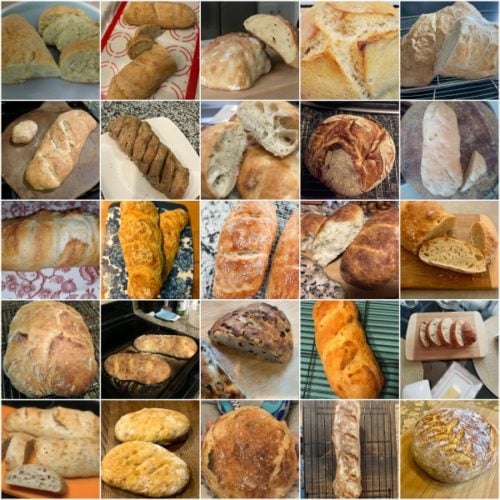











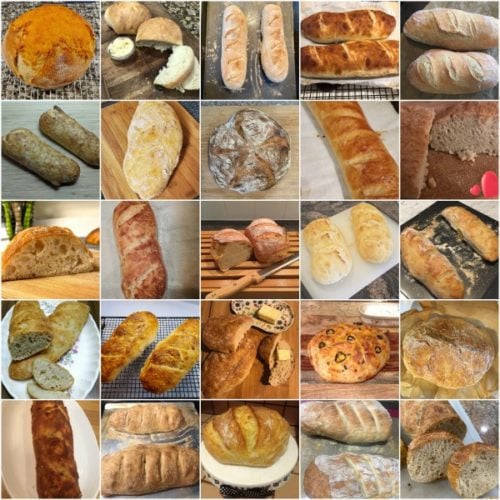
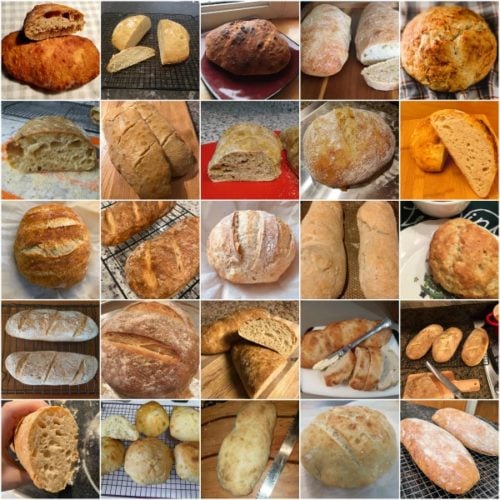











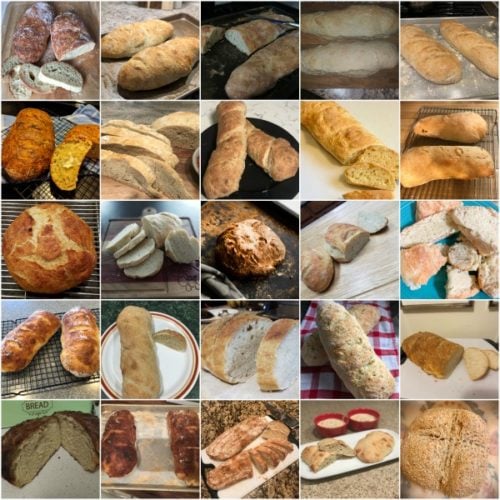











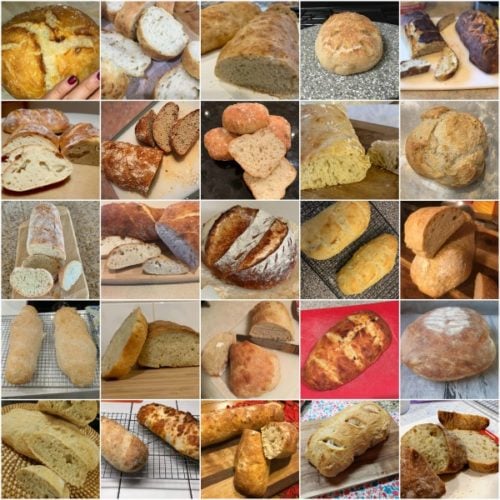


























Absolutely amazing!! I’ve been wanting to make bread but everything I found required a starter until I found this recipe and let me tell you, it is perfection and SO EASY to make. I made the mistake of being too excited and didn’t let it rest 45 min before getting placed in the oven. It is still amazing! Made the jalapeño cheddar version and I cannot wait to try more!
Delicious! I love the bread recipe and make it al the time.
My first bread making attempt and it was lovely. However I have a question. Do you have any tips pm how to store the bread so the crust stays crispy?
Hi Joyce, if you store in a container or zipped-top bag, leave the corner popped/open just a bit to let some air in. That will keep the crust crispier for a bit longer. Glad you enjoyed the bread!
I made this bread a couple years ago and loved it! Now I’m back to your page again, but I want to half the recipe. Should I half all the ingredients? And what about the bake time if I put that smaller boule in a Dutch oven?
Hi Emily, we generally advise against halving yeast recipes. We’d recommend making the recipe as is and freezing the other half. See recipe Notes for details! We’re unsure of the exact time for a smaller boule, so keep a close eye on it. An instant-read thermometer will be helpful for determining when it’s done.
I made this recipe today!! First time I have baked bread in 50 years! Easy and delicious.
Love this recipe! I make it all the time. Thank you!
Just a question, will stretching and folding the dough while it’s proofing make it even airier? Or should I just leave this recipe no-knead? Haha just curious!! Thank you
Hi Kara, this dough should not be kneaded and handled as little as possible. More on the method in the post above! If you’re interested, here are even more yeasted bread recipes—many of which require kneading.
Everything was fine with this recipe except for one thing. The temperature is way off. I think it needs to be around 375 maybe not 475
Hi Nate, did your bread seem to brown too quickly? We’ve never had issues baking this bread at 475 degrees, but you can certainly use a lower temperature if you prefer. Keep in mind that the bake time will be longer if using a lower temperature. Thanks for giving this one a try!
Hi! Just wondering if this could be made into one large loaf instead of two small / one boule. If so, what pan size / baking time do you recommend? Thanks!
Sure can! See the recipe notes for details on how to make one large round loaf.
My bread does not always come out the way I want it to. I have never done the refrigerator method but this was a very easy recipe to make and it came out perfectly!
So easy! So delicious!
I cannot wait to try this recipe. Question, I have a mini loaf pans that makes several small loaves, would this recipie work OK. If so should I cut the time down a good bit? Thanks making it with my students
Hi Kristen, You can make these mini! Bake time will be similar, even a couple minutes shorter.
Such a great recipe! I am getting more and more confidence baking with yeast, thanks to your helpful comments and directions. My only question for this one—can I bake the loaves on parchment if I am not certain my baking sheets are non stick? I did this time, but not sure if it would come out crispier if I cooked directly on baking sheet. (I did the boiling water step, and it was crusty and brown, just curious about the parchment) Thank you so much for all of your recipes!! They are wonderful!
Hi Wendy, If you don’t have a nonstick baking sheet, line it with parchment paper instead. Coat with a dusting of flour and/or cornmeal before placing the dough on top. Parchment paper can burn, so it’s best to check the box to see how much heat yours can tolerate.
I love this recipe! First time ever making bread and I’ve made it three times so far!
My loaves however are very dense. Ive rested it for three hours and 24 hrs, with no difference. I bake it in my Dutch oven using the instructions. Was wondering if there was something I wasn’t doing properly.
Hi Mary, we’re happy to help troubleshoot. How did you measure your flour? Be sure to spoon and level (or use a kitchen scale) so that the flour isn’t over measured. Too much flour can dry out the bread and make it seem a bit dense. And also make sure to handle the dough with extra care to prevent popping the air bubbles before baking. So glad you enjoy this recipe!
can I make bread without yeast , using baking soda/baking powder instead?
Hi Joan, no, yeast is necessary for this bread recipe. Here is our no yeast bread recipe instead.
Great, easy bread recipe. I’ve tried many bread recipes over the past 3 years and this recipe beats them all hands down.
Quick question – the bread tasted great – but was very pale. Should I have brushed it with egg or something?
Hi Chris, so glad you enjoyed it! Have you tried baking the loaves either in a Dutch oven or with a water/steam bath (optional step 7 in the recipe)? The steam helps create that crispier, golden brown crust.
I absolutely love this recipe. I’ve made it countless times and everyone loves it! This time, I forgot to set a timer during the initial rise and let it rest at room temp for nearly 5 hours. Is there anything to be done to salvage it?
Hi Chloe, you can move ahead with the recipe, if anything, your loaf may be a bit shorter/denser if the dough rose too much during that time. Glad this is a favorite for you!
Hi, I have never baked before and after trying your recipe, I’m hooked onto baking! My family loved the bread which gives me a lot of encouragement to bake more!
There are some points that I’ve encountered which I would like to seek your advice:
1) when the dough is in the fridge, there tend to be water droplets forming on the covered cling wrap. And after 3 days, when I remove the cling wrap, I can see some water at the side of the dough in the bowl. I would sprinkle some flour at the sides to try and absorb the water. Is it normal?
2) after 3 days in the fridge, the dough is still sticky and very hard to shape it as it is very sticky. I have to heavily flour the work area and also lightly flour the top of the dough before pouring it out. In this way I can shape the dough. Is this correct?
Thank you so much for your attention, and your recipe!
Hi JQ, we’re so glad you and your family enjoyed this bread! Yes, a bit of condensation on the wrapping and the bowl is normal. This is a sticky dough, but there are quite a few different factors that go into the consistency of dough, down to even the weather and amount of humidity in the air. There’s nothing wrong with adding a bit more flour to bring the dough to a workable consistency. You could try adding an additional Tablespoon of flour when you’re mixing the dough, or just continue to heavily flour your work area when preparing the dough to bake. Hope this helps for next time!
Thank you so much for the reply!
I have another question, if I want to add cheese into the recipe, which step should I add it to? Thank you once again
Sally…I’ve made your recipe three times now, added rosemary the second time, great taste. I think I like it best unflavored though.
Bt question I have is this…the first time, I had nice big openings in the dough body after baking, looked just like your pics. But the second two times, the finished dough/body has next to no such openings, and is in fact a bit doughy in center. And I meticulously followed instructions and ingredients all three times, changed nothing from one time to next.
What could be causing this? While they all taste good, I much prefer the big cavities in the dough of the finished loaf. Any suggestions would be appreciated.
Hi Dennis, so glad to hear that you’re enjoying this bread! The air pockets in baked bread can really vary by loaf, but be sure to handle the dough with extra care to prevent popping the air bubbles before baking. Hope this helps!
This was my first recipe I tried on your site and my husband asks for it weekly
I discovered this recipe last week and I’ve made it every day since It’s incredible, very tasty with a gorgeous ciabatta texture! It’s also so easy, you can make it every day with no problem (you really do just put the ingredients in a bowl, stir, leave, put it on a tray, leave again and bake! Thank you
I made this bread for my son’s birthday dinner. The whole family loved it! The first loaf was gone before you know it!
Hi! Planning on making midweek to chill until baking on Saturday for dinner. I want to be completely clear: if using active yeast, you don’t need to proof it? You really just mix everything all at once?!?! This feels too good to be true!
Hi Kathleen, it’s not necessary but feel free to proof the yeast before starting if you’d like – you can proof instant yeast just as you do active dry (non instant) yeast. For this particular recipe, we would warm 1/2 cup (60ml) of the water to about 100°F (38°C), whisk in the yeast and a very small amount of granulated sugar (about 1 teaspoon). Cover and let it sit for 5-10 minutes. If the yeast is active, the top of this mixture will foam. Then mix in the rest of the water and other ingredients. Proceed with the recipe as written.
This recipe was fabulous. Me and my grandson made the bread. Excellent! I’m going to try
out the bagels.
This was awesome and so easy to make.
I was nervous u til it came out of the over because the tough is so sticky, but it really made an amazing bread. And I didn’t even refrigerate the dough first. Next time i will.
I used this recipe to make my first ever loaf of bread & it turned out great! My son said that if he hadn’t known that I made it, he’d have thought it came from a fancy bakery. 🙂 Thank you for this recipe & the clear instructions!
This is a great recipe and makes wonderful bread but the weight amount of 430g of bread flour is much lower than the calculated weight from the bag of my bread flour. Do you use a specific brand of flour? My bag says 36g=1/4 cup so it would be 468g = 3-1/4 cups. I always use weights over volumes with dry ingredients when possible so when I made this recipe the first time the dough was way too wet. I had to keep adding flour. Once I had the dough right though, the bread came out delicious.
Hi Denise, what brand are you using? I usually use King Arthur brand, which actually says it’s 120g/1 cup. When I weigh 1 cup (spooned and leveled), it’s closer to 130g and that is what I use. I slightly rounded it up here, because you usually need a little more flour.
I had this same issue. I used 430g of organic King Arthur bread flour, and the dough was immediately wet and sticky with hardly any stirring at all. It didn’t look dry like the dough in your video did when you first started mixing it. I added a little more flour but was afraid of adding too much. I’m baking it tonight, so we’ll see how it turns out!
Hi! We devoured this bread. Can I make this into one bigger long loaf instead of two??
Hi Kate, absolutely. Bake time may vary. We’re so glad you enjoyed this one!
Made my bread fist time today. It was delicious but I did not get the browning on top that you have in your or pictures. Nor did I have the flour on top.
My first time baking bread and it came out so good! I added some rosemary and basil and garlic salt on top as well as some flour, and it came out perfect. My family is so happy!
Made my bread fist time today. It was delicious but I did not get the browning on top that you have in your or pictures. Nor did I have the flour on top. Did I do something wrong in baking??
Hi Deb, how is the inside of the bread? It sounds like the bread may need just a few minutes longer in the oven to help it achieve a more golden exterior. You can also try the steam method (outlined in step 7) that will give the bread a browner, crispier crust. We’re glad you’re enjoying this bread!